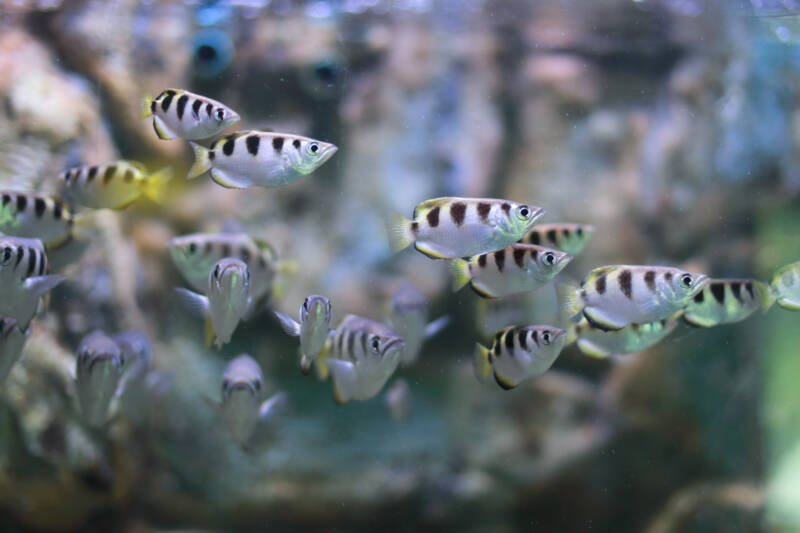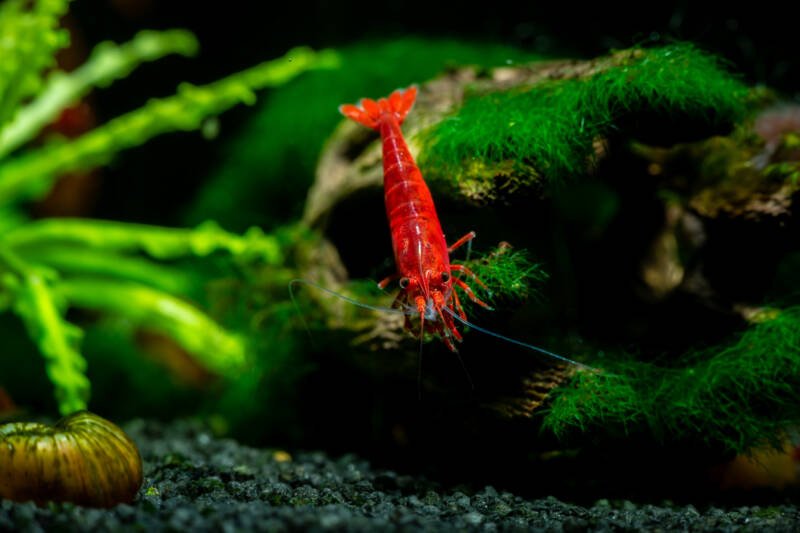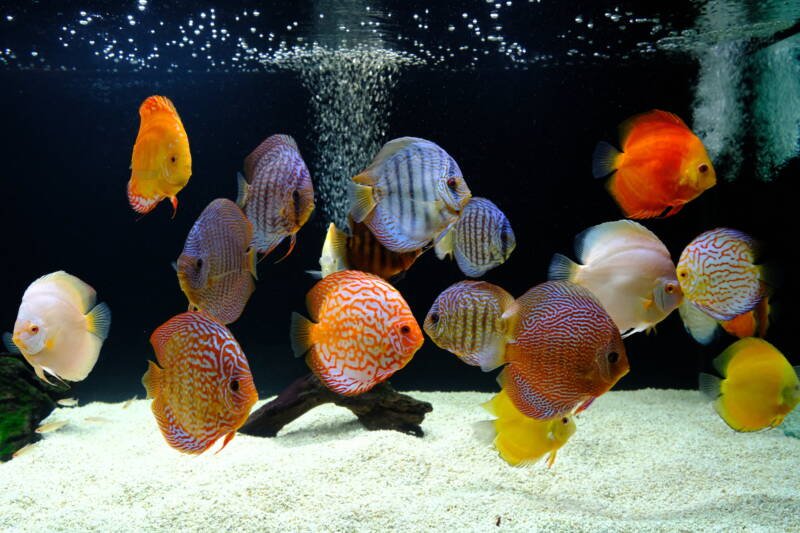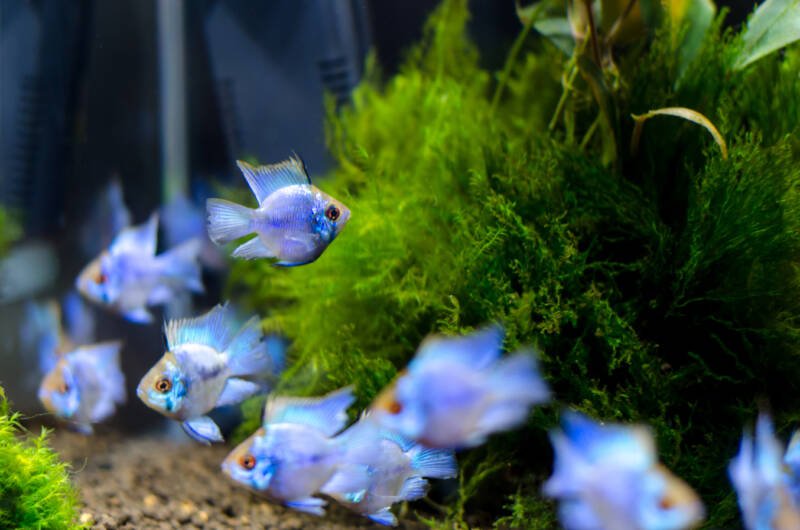Aquarium hobbyists sometimes ask why they need a water conditioner.
Chances are you were told to use a conditioner when you first started in the hobby. Maybe you read something online about how tap water is bad for your fish.

We’ll explain what’s in tap water and explore what you need to be concerned about. Then, we’ll look at ways of making tap water safe for aquarium without using a water conditioner.
In this article
What’s in My Tap Water?
Tap water, whether it is from a well or a water treatment facility, contains a variety of minerals like calcium, magnesium, sulfates, and carbonates. These minerals are harmless and pose no harm to aquatic life.
Your water could also contain nutrients like phosphate and silicate, along with nitrate and iron.
Heavy Metals and Tap Water
Copper, zinc, and other metals are known as essential trace elements because they are required by plants and animals to thrive.
Take a look at the ingredient list on a can of fish food or aquarium plant fertilizer. You’ll find one or more trace elements listed.
The natural ingredients used to make fish food, like fish meal or pea protein, also contain these trace elements. When fish digest the food, the trace elements are absorbed and used to build new tissue and keep the fish healthy.
If the level of metals like copper is high, they’re called heavy metals. If the level of copper is too high in your tap water, it can stress or harm your fish and invertebrates.
High copper levels in tap water are quite common. It’s caused by copper leaching from copper plumbing inside the home.
Heavy Metals and Fish or Invertebrates

Heavy metals accumulate in the fish’s organs and tissue. The harm comes over time as metals “bioaccumulate” inside the fish.
Metal toxicity causes your fish to have a short life and be more susceptible to disease problems.
Chlorine Disinfectants
Municipal water treatment facilities add chlorine disinfectants to the water before it is pumped out to your home.
Disinfection is required to prevent the growth of microbes in the water supply. Chlorination prevents bacteria and parasites from getting into your drinking water.
Unfortunately, these disinfectants are toxic to aquarium life. Common chlorine disinfectants added to drinking water include:
- Chlorine
- Chloramine
- Chlorine dioxide.
Chlorine Toxicity and Aquarium Fish

Chlorine disinfectants are “oxidizers.” Chlorine compounds enter cell walls and kill microbes like bacteria, fungi, and parasites.
With fish and other aquatic life, chlorine compounds damage delicate gill tissue, disrupt red blood cell levels, and interferes with many other biological functions.
Aquarium fish can die in minutes if the chlorine level is high enough.
What about Well Water?
Unlike municipal water supplies, private wells are not regulated by the government. So, there is no requirement to chlorinate the water, but some well-owners choose to inject chlorine into their water supply.
Coliform bacteria frequently contaminate private wells. Chlorination is used by the homeowner to kill the bacteria and make the well safe to drink.
Well water can be very acidic, causing copper pipes to release copper into the water. As a result, copper levels can be very high in acidic well water.
What do Water Conditioners Do?
There are a lot of aquarium water conditioners on the market. It can be hard to sort through all the claims.
The primary role of all water conditioners is to quickly neutralize chlorine disinfectants so you can immediately add water to your tank.
Water conditioners contain chemicals that react with the disinfectants, rendering them harmless.
Some aquarium water conditioners contain a chemical that detoxifies heavy metals. The chemical wraps itself around the metal, making it non-reactive. This protects aquatic life from heavy metal poisoning.
Chloramine and Ammonia
While chlorine is an effective disinfectant, it has a problem. Chlorine reacts with trace amounts of naturally occurring organic compounds, forming cancer-causing byproducts in some drinking water supplies.
To get around this, treatment facilities use chloramine. Chloramine is a combination of ammonia and chlorine.
Chloramine does not form cancer-causing byproducts. However, it is still harmful to aquarium fish.
When water conditioners neutralize chloramine, a small amount of ammonia is released into the water. The good news is the ammonia level is so small you won’t be able to measure it on a test kit.
The trace amount of ammonia is harmless to the aquarium and will be used up by the biological filter.
Other Ways of Making Tap Water Safe

Even though aquarium water conditioners are safe and have been used on millions of aquariums, some aquarists worry about adding “chemicals” to their tanks.
Others wonder if there are other methods of making tap water safe without using a water conditioner.
There are several ways to “condition” tap water, but not all are equally effective. Let’s take a look at each one.
Letting the Water Age
“Aged” tap water is a combination of myth and science. Early aquarists would fill a bucket with tap water and let it sit for a few days or weeks. They believed something happened to the water to make it more “fish friendly.”
If the water was treated with chlorine, the aging process would give the chlorine a chance to dissipate from the water. Given enough time, chlorine will evaporate from standing water.
Aeration
Aerating tap water is similar to “aging.” Instead of waiting a couple of days for the chlorine to leave, aeration drives off the chlorine in a matter of hours in most cases.
The problem with aging and aeration is that it does not work if your tap water contains chloramine.
The chloramine molecule resists aeration and stays in the water.
If the water contains heavy metals, like copper, it will remain in the water after aeration and aging.
Activated Carbon
Activated carbon removes chlorine and chloramine from tap water. The chlorine disinfectants react with the activated carbon and are neutralized.
You don’t want to rely on your aquarium filter to neutralize chlorine. It will take too long, and your fish will be exposed to the damaging effects of chlorine.
A faucet filter that uses activated carbon will remove chlorine and chloramine. Some faucet filters will also remove heavy metals.
Reverse Osmosis
The most effective way to purify tap water is with a reverse osmosis (RO) filtration system.
RO filter systems pass tap water through a series of specialized filter chambers. Reverse osmosis filter systems remove:
- Chlorine
- Chloramine
- Heavy metals
- Nutrients like phosphate and nitrate
- Salts and minerals.
RO water can be blended with conditioned tap water to create just about any hardness and pH level.
Since it is free of algae-promoting nutrients, your tank will stay cleaner and require less maintenance.
Ultraviolet Light
UV light reacts with chlorine, forming a harmless salt. That’s why chlorine must be continuously tested and added to outdoor swimming pools.
Sunlight slowly neutralizes the chlorine. UV light is sometimes used in industrial processes when adding a chlorine neutralizing chemical is not possible.
Using UV to make tap water safe for your aquarium is not practical. UV neutralization requires a large, high-powered UV fixture and a long contact period with the water.
A UV unit that neutralizes chlorine is not as effective for chloramine. A different type of UV light is required for chloramine. UV-based chlorine removal is best left to industrial engineers.
Vitamin C
Vitamin C (ascorbic acid) is another industrial chemical that has been used to neutralize chlorine in drinking water distribution lines.
When underground water lines are repaired, they must be heavily chlorinated since the pipe repair is located in a muddy hole in the ground.
Vitamin C is used to neutralize the high chlorine level in the drinking water line because it is safe for people to drink.
Ascorbic acid is highly impractical to use as an aquarium water conditioner.
You would need a laboratory scale capable of measuring 0.002 ounces of vitamin C powder. That’s what is needed to treat 10 gallons of tap water. Are you willing to spend at least $800 for a laboratory scale?
Final Thoughts
Aquarium water conditioners have been used for decades to treat millions of gallons of tap water. They’re safe, fast-acting, and ensure your tap water is OK for your aquarium.
A reverse osmosis filtration system is the best water conditioner alternative. An RO will remove chlorine disinfectants along with algae-promoting nutrients, minerals, metals, and organic pollutants.
If investing in an advanced tap water filtration system is not for you, stick with a well-known aquarium water conditioner. We have another interesting article about aquarium water types and sources, check it out!
If you have questions or comments, please leave them below.